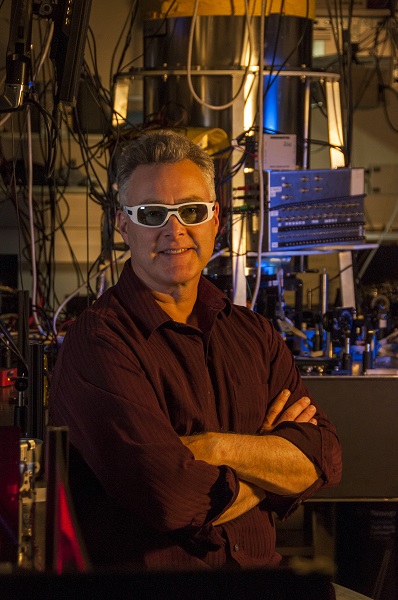August 6, 2014
Physicists at the National Institute of Standards and Technology (NIST) have demonstrated a pas de deux of atomic ions that combines the fine choreography of dance with precise individual control.
NIST’s ion duet, described in the August 7 issue of Nature,* is a component for a flexible quantum simulator that could be scaled up in size and configured to model quantum systems of a complexity that overwhelms traditional computer simulations. Beyond simulation, the duet might also be used to perform logic operations in future quantum computers, or as a quantum-enhanced precision measurement tool.
In the experiments, researchers coaxed two beryllium ions located in separate zones of an electric-field trap (a storage device) into an “entangled” state. An important resource for quantum technologies, entanglement involves an intimate connection between the particles such that a measurement of one ordains the state of the other. This is the first time ions in separate zones have been entangled by manipulating their electric interactions, an important feature that could be used in quantum simulation and computing.
The work demonstrates a high level of quantum control with microfabricated trap technology well suited to the scaling-up needed to make powerful quantum information processors. Having separate trapping zones enabled the research team to tune the ions’ interactions from weak to strong—a feature expected to be useful for simulating the behavior of complex quantum materials.
“Even though the ions are confined apart from one another, we can now entangle them,” NIST physicist Andrew Wilson says. “We plan to use this for quantum simulation and computing, but when I explain to my family what we’re doing, the remote entanglement sounds kind of romantic.”
“We focus on the idea that everything needs to be scalable,” Wilson notes. “To do useful simulations we’ll need versatile traps with more than two ions, and making traps using the same technology used to make computer chips gives us this capability. NIST pioneered this approach and we’re fortunate to have great facilities for doing this sort of work.”
Inducing the ions to perform a number of intricate quantum dances, the researchers first coaxed the ions to exchange a single quantum of vibrational energy (the smallest amount that nature allows). They then used lasers and microwaves to entangle the ions’ “spins.” Analogous to tiny bar magnets, the spins of the entangled ions pointed in the same direction, but were also in a “superposition” of pointing in the opposite direction at the same time. Superposition is another strange but useful feature of the quantum world.
The researchers say that extending the new module to make a two-dimensional network of a few tens of ions would be enough to perform useful simulations of phenomena that are extremely difficult to model even on the most powerful traditional computers. An example is the high-temperature superconductitivity—electron flow without resistance—observed in certain ceramics. Despite more than 20 years of study, the underlying mechanism remains a mystery. A quantum simulator might provide deeper insights.
The ion duet also could be used to perform logic operations in quantum computers, which would have a wider range of applications than quantum simulators. And NIST researchers also envision the ion duet as a sensor, in which one well-controlled ion is used to investigate a second ion with interesting features. For instance, a beryllium ion might be used to probe a charged anti-matter particle in another trap zone, Wilson says.
This research was funded by the Office of the Director of National Intelligence, the Intelligence Advanced Research Projects Activity and the Office of Naval Research.
*A.C. Wilson, Y. Colombe, K.R. Brown, E. Knill, D. Leibfried and D.J. Wineland. Entangling spin-spin interactions of ions in individually controlled potential wells. Nature. August 7. DOI 10.1038/nature13565.















